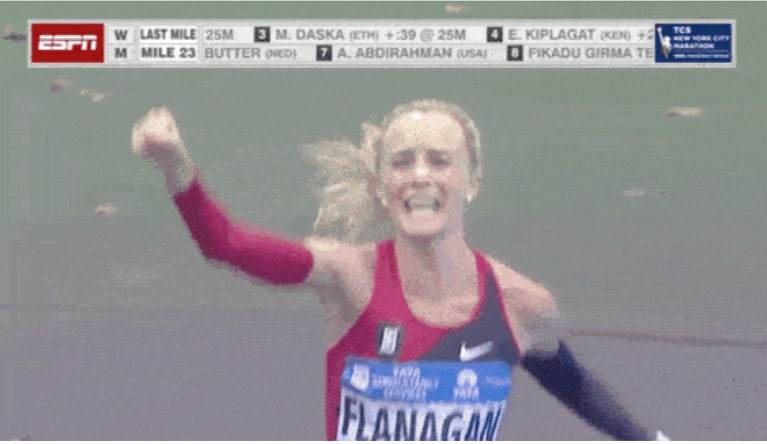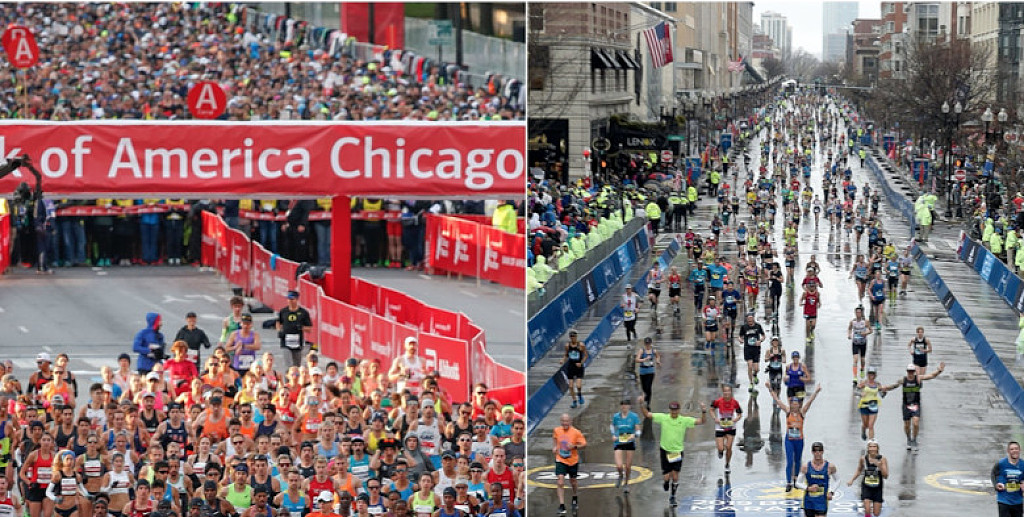Running News Daily
Running News Daily is edited by Bob Anderson. Send your news items to bob@mybestruns.com Advertising opportunities available. Train the Kenyan Way at KATA Kenya and Portugal owned and operated by Bob Anderson. Be sure to catch our movie A Long Run the movie KATA Running Camps and KATA Potato Farms - 31 now open in Kenya! https://kata.ke/
Index to Daily Posts · Sign Up For Updates · Run The World Feed
Thinking About the Boston-Chicago Double? Before You Commit, Here Are a Few Things to Consider
The rare chance to run two major marathons on back-to-back days is tempting...
The 2021 World Marathon Majors schedule isn’t set in stone, but if all goes to the current plan, it is going to look vastly different this fall.

With the announcement that the Boston Marathon will take place on October 11, the six World Marathon Majors will be run within a six-week period between September 26 and November 7. And, don’t forget about the Olympic Marathons, which will take place on August 7 (women’s) and August 8 (men’s).
Berlin Marathon: September 26
London Marathon: October 3
Chicago Marathon: October 10
Boston Marathon: October 11
Tokyo Marathon: October 17
New York City Marathon: November 7
Yes, you’re seeing that correctly—Chicago and Boston are scheduled to be on back-to-back days.
This isn’t the first time we’ve seen back-to-back marathon majors like this. The London Marathon and Boston Marathon have been a day apart 11 times in the history of the races, since both events happen in April. The most recent occurrence of this was in 2011.
While we may see watered-down elite fields at these races as a result of this packed schedule, an intriguing challenge has also emerged: a marathon major double with Chicago and Boston.
In additional to a physical challenge, the logistics of running races in different parts of the country on consecutive days is complex—but it’s not unheard of. We see this in the World Marathon Challenge, where runners like Becca Pizzi run seven marathons in seven days on seven continents. Michael Ortiz, a New York City-based runner, ran back-to-back 100-milers on his quest to complete 100 100-milers in 100 weeks, which he finished in October 2020.
The master of consecutive races is Michael Wardian. He did 10 marathons in 10 days, and he’s even doubled up marathons on the same day when, in 2013, he won the Rock ’n’ Roll San Antonio Marathon in the morning and then took 10th at the Rock ’n’ Roll Las Vegas Marathon that night.
If your interest is piqued by this challenge, here’s a few things you need to consider, with some tips from the master himself.
You need to get entry into each marathon
For starters, the races are tough enough to get into, with Chicago’s drawing and guaranteed-entry systems, and Boston’s qualifying times.
If by chance you do get into both, you’re shelling out $180 for Boston and $205 for Chicago, and that’s if you’re from the U.S. If you’re an international runner, the race entry fee is more like $240 and $230, respectively.
You need to pick up both race bibs
An often-overlooked facet of race weekend is bib pickup. Typically these large marathons don’t have race-day bib pick-up, which poses a problem if you’re running another marathon the day before the race.
Some races, like Boston, are usually pretty good about letting someone else pick up your bib for you, if you follow their requirements. Wardian recommends recruiting a team to help you out with this.
Here’s a possible scenario for the Chicago-Boston weekend:
Fly to Boston on Friday to get that bib
Fly to Chicago on Saturday to pick up that bib
Run the Chicago Marathon on Sunday, then later in the day fly to Boston
Run the Boston Marathon on Monday
But that extra flight and overnight stay in Boston is big cost just to pick up a bib. And speaking of costs...
The cost of traveling from the Midwest to New England on race weekend will be high
Assuming someone can pick up your bib for you in Boston, you’ll need, at minimum, a flight from your hometown to Chicago, a flight from Chicago to Boston, then a flight from Boston back to your hometown. If your hometown is either Chicago or Boston, then lucky you! You can eliminate one of those flights.
Flights are cheap right now because of the pandemic, but they could go up soon if COVID-19 cases start to decline, with the vaccine. In the third quarter of 2019, the average cost of a flight originating at Chicago’s O’Hare airport was $333.50, and the average cost of a flight originating at Boston’s Logan airport was $329.45, according to the Bureau of Transportation Statistics. (However we recently spotted some late-afternoon, one-way flights from O’Hare to Logan for less than $200 on Google Flights!) Based on that information, your flights could run you close to $1,000.
Keep in mind, because you have a limited window for the time of departure for your flight from Chicago and Boston, the best option time-wise might not be the cheapest option available. Remember, your whole morning and early afternoon are likely spent running and getting to the airport. Also you won’t want to arrive too late in Boston, since you have an early wakeup to get out to Hopkinton.
Let’s say you take an Uber to the airport for each flight, and with expected surge costs, that could cost you $50 per Uber ride. Add in two nights of hotel stays, which will likely surge as well because of the big crowds in town. A quick scan of TripAdvisor shows that both Chicago hotel rooms and Boston hotel rooms the night before the respective marathons are running upward of $400.
And this doesn’t even including food! Which means you’re easily looking at $2,500 spent on the weekend—and I think that’s generous estimate.
Consider the training and between-race recovery
If you’re still not deterred by those unique logistics and costs posed by the possibility of a Chicago-Boston double—or even doing all six marathons in six weeks—Wardian has some tips for you. (And no, Wardian has not committed to doing the six-in-six, but he said it piqued his interest.)
Train for this race weekend like you would for an ultra.
Get your body used to running back-to-back hard efforts by doing back-to-back long runs. This way, you’ll be used to feeling heavier legs on day two much earlier than when you’re fresh.
Pack light when traveling.
You can check a bag, but like any race, bring your shoes, apparel, and fuel for the race in your carry-on. I put my gels in a Ziploc bag when going through security, and I don’t usually have a problem. Speaking of gels, you’ll need gels or chews for two races. Don’t forget that.
Eat soon and often.
When you finish the first race, get your drop bag, change into some warm clothes, and start getting calories in. I focus on drinking coconut water and having a smoothie. On the plane, bring your own water bottle and food, so you don’t have to rely on the flight attendants. These collapsible water bottles are great for traveling.
Recovery is key, especially on the airplane.
I wear my CompresSport compression gear during my first race. After that, I try to get my feet elevated for a bit. On the plane, I try to book an aisle or window seat so I can stretch my legs a bit. I also bring a lacrosse ball and use it to roll out muscles when I’m sitting. Also, get up and walk around every 45 minutes during the flight—you likely will have to, with how much water you’ll be drinking. Highly recommend the aisle seat.
by Runner’s World
Login to leave a comment




